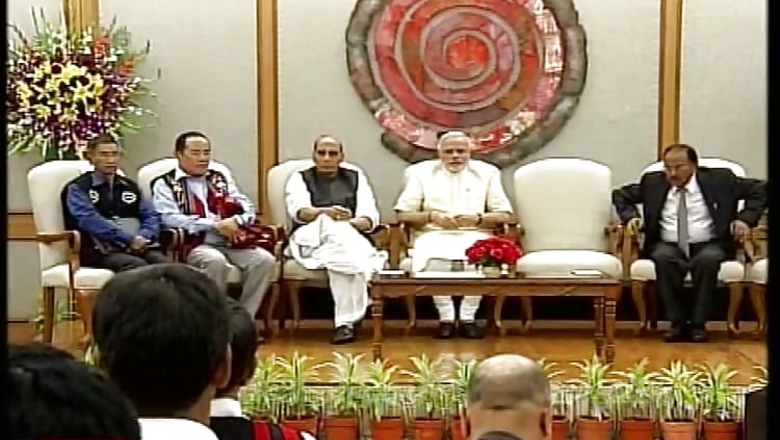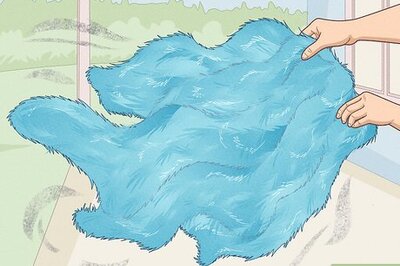
views
On August 15, 1947 India overthrew the British rule and became independent. But just a day earlier, Nagas revolted against the Indian government, declaring that they were a separate nation and would not accept New Delhi's rule.
Led Angami Zapu Phizo, the Nagas comprising of 17 major tribes and 20 sub-tribes, united under the banner of Naga National Council (NNC) in August 1947 to carry out the fight against India. Ao, Angami, Sema, Lotha, Tangkhul, Konyak, Rengma and Mao are some of the major Naga tribes and although each one of them speaks a different language, all of them demanded an independent Nagaland.
The Indian government arrested Phizo and a few of his close associates in July 1948. But Phizo was released in 1949 and went on to take over as the NNC president in 1950. Under his leadership the NNC publicly declared its aim to establish a sovereign Naga state comprising of all Naga dominated areas of the Northeast.
NNC also held a ‘referendum’ in May 1951 claiming 99% of the Nagas voted in favour of an independent Nagaland but it was never accepted by the Indian government. The first general elections in 1952 were boycotted by the NNC and it started a violent secessionist movement making Naga insurgency the oldest in India.
According to South Asia Terrorism Portal (SATP) in the first few years, NNC cadres would raid villages and police outposts for funds and arms but on March 22, 1956, Phizo created an underground government called the Naga Federal Government (NFG) and a Naga Federal Army (NFA). In April 1956, the Indian Army was called in to crush the insurgency in what was, till then, the Naga Hills District of the State of Assam. To deal with the situation, the Armed Forces (Special Powers) Act, 1958, was subsequently enacted. Phizo, however, escaped to the then East Pakistan in December 1956 and, subsequently, to London in June 1960.
Assam was divided on December 1, 1963 and Nagaland became a separate state and another round of attempts were made for a political settlement. Freedom fighter Jai Prakash Narayan, the then Assam chief minister Bimala Prasad Chaliha and Rev. Michael Scott led a Peace Mission to Nagaland in April 1964. An agreement for Suspension of Operation (AGSOP) was signed with Naga insurgents on September 6, 1964 raising hopes of a peaceful solution.
But NNC cadres soon broke the agreement and launched a series of attacks on security forces and Army units posted in the area. Finally, the Peace Mission came to an end in 1967 after six rounds of talks between the insurgents and the Centre which failed to yield any positive result.
NNC and its constituents the NFG and the NFA were declared "unlawful associations" under the Unlawful Activities (Prevention) Act of 1967 and banned by the Centre in 1972. SATP reports that security forces launched a massive counter-insurgency operation and once again brought the situation under control forcing the insurgents to the negotiating table.
An agreement known as the Shillong Accord was signed between the Centre and a section of the NNC and the NFG on November 11, 1975. According to the terms of Shillong Accord, the NNC-NFG accepted the Indian Constitution and agreed to come overground and surrender their weapons.
However, a group of about 140 activists of the NNC, who had gone to China for training, repudiated the Shillong Accord and refused to surrender and formed another terror group called National Socialist Council of Nagaland (NSCN). The NSCN leaders were Thuengaling Muivah, Isak Chisi Swu and SS Khaplang and the group was formed in Myanmar (then Burma) in 1980.
Soon NSCN became the most powerful and feared terror groups in Nagaland and the Northeast with the NNC-NFG became less active and losing its influence.
The division of Nagas along clan and tribal lines also played a major role in the insurgency and formation of different terror groups. While a majority of the rank and file of the NSCN was from the Konyak tribe, the leadership was Tangkhul dominated leading to discontent among the former. There were also apprehensions among the Konyaks and the Myanmarese Nagas that the Tangkhuls were about to strike a deal with the Indian government.
These factors resulted in a vertical split in the NSCN in 1988. The Konyaks formed a breakaway faction under the leadership of Khole Konyak and SS Khaplang, a Hemie Naga from Myanmar. The Tangkhul faction was led by Isak Swu, a Sema from Nagaland, and Muivah, a Tangkhul from Manipur’s Ukhrul district. This was followed by severe inter-factional clashes in which hundreds of activists of the rival groups had been killed.
After the death of Phizo in 1990, there was another split in the NNC. Phizo’s daughter Adino, an Angami, and Khudhao Nanthan, a Sema and a close associate of Phizo, constituted separate groups on rival lines. In the winter of 1996-97, Khudhao joined NSCN (lM) and is currently the Vice Chairman of the organization. With this move NSCN (IM) was also able to get the support of the Lothas to which Kudao belongs .All factions of the NSCN and NNC (Adino) have been banned since 1991 under the Unlawful Activities (Prevention) Act, 1967.
The NSCN-IM lays primary emphasis on the point that the Naga region was never a part of India and that freedom fighter and India’s first prime minister Jawaharlal Nehru’s argument was fallacious when he said that India had "inherited" the Naga area from the British. Both Swu and Muivah argue that "the fate of a people cannot be passed on like an inheritance from one party to another". The NSCN-IM has taken an inflexible stand on this point and insists that their demand is not for ‘secession’ because they have never been a part of the Indian Union.
But the specifics of the peace deal signed between the Narendra Modi government and NSCM-IM in New Delhi are still not out in public domain. NSCM-IM’s main demand has been the creation of a ‘Greater Nagalim’ which will also have several districts of Assam, Arunachal Pradesh and Manipur. The other three states have made it clear that even though they have Naga tribes residing within their boundaries but they will not allow those areas to be a part of ‘Greater Nagalim’ as demanded by the NSCM-IM. In fact according to Naga insurgent groups the 'Greater Nagalim' should also include Naga-dominated areas of Myanmar.




















Comments
0 comment